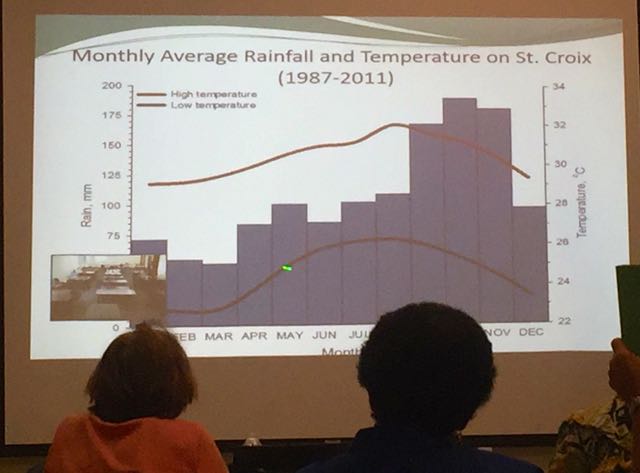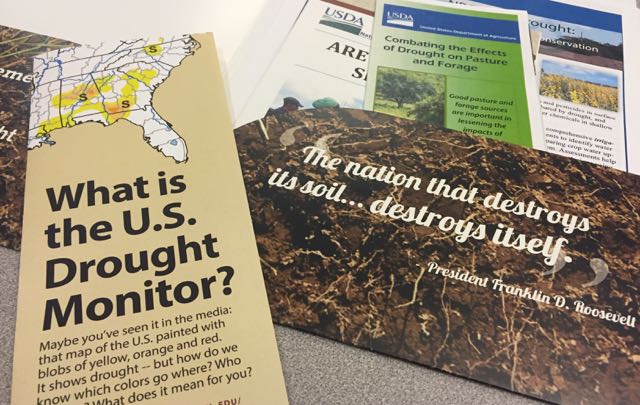
Last year’s drought was a huge blow to the territory’s agriculture sector: It killed off livestock animals and decimated fruit trees and numerous crops. In addition to speeding the time federal funding comes in during a drought disaster, a monitoring tool could also help farmers better understand water conditions and manage their usage accordingly.
Known as the U.S. Drought Monitor, the tool combines a number of climatological factors, including both historical and current precipitation data, as well as economic impacts to agriculture to determine if an area is experiencing drought.
Agriculture Commissioner Carlos Robles told forum attendees that during the 2015 drought Yvette Browne of Sejah Farms reached out to him about getting a declaration of drought so the territory could receive disaster funding.
It was then that Robles said he searched online and found out about the U.S. Drought Monitor and was surprised to see that Puerto Rico, including the similarly sized islands of Vieques and Culebra, but not the Virgin Islands, were part of the weekly drought assessments. The territory couldn’t simply request to be on the map, though, since it didn’t have the adequate data collection systems put in place yet.
“We had to develop an on the ground story before we convinced the Farm Service Agency and the Secretary of Agriculture to make a declaration of drought in the Virgin Islands,” Robles explained, adding that newspaper clippings and Facebook photos of starving cattle were part of the evidence his department gathered.
Assistance programs paid farmers for feed they had to buy during the drought, since grazing grass was scarce, and another provided money for livestock that died as a result of the drought.
Having a systematic data collection system in place that collects data for the drought monitor would have been a much faster and easier way to prove the territory was in a drought. But getting on the monitor takes a lot of planning, as a significant amount of data has to be collected and sent on a weekly basis to the national team that puts out the map out every Thursday.
Organized by the U.S. Department of Agriculture and the National Drought Mitigation Center in partnership with the University of the Virgin Islands, V.I. Department of Agriculture, National Oceanic and Atmospheric Administration’s National Weather Service and the V.I. Territorial Emergency Management Agency, the forum called on local agency personnel, farmers, researchers, teachers and students to determine what steps need to be taken to get the Virgin Islands on the weekly map.
To learn more about the drought monitor and data requirements, attendees heard from a handful of the authors who produce the national monitoring map on a weekly basis. A few dozen people attended the forum at UVI on St. Croix and about 10 participated via videoconference from the St. Thomas campus.
Brian Fuchs, a climatologist with the NDMC, said that between 40 and 60 different indicators are collected for each locale depending on its particular characteristics. Precipitation, drought indices, stream flow, soil moisture, ground water and satellite data are all common indictors. The climatological record for each indicator is important too, since there needs to be a historical baseline by which to assess “normal” conditions.
“We’re going to need the stakeholders, we’re going to need the local experts, we’re going to need the participation,” Fuchs stated. “It’s good for one person to take the lead but we still need multiple people to champion the effort.”
A number of local professionals spoke during the forum, including Jaime Valentin of the Natural Resources Conservation Service, William Gould of the USDA Caribbean Climate Hub, professor Robert Godfrey of the UVI Agricultural Experiment Station, Kristin Wilson-Grimes of the UVI Water Resources Research Institute, Christina Chanes of the UVI Cooperative Extension Service and David Morris of the UVI science and math department.
It was clear from their talks that a significant portion of the local climatological data needed for the monitor is already being collected and there’s even a large chunk of historical precipitation data available.
Mark Svoboda from the NDMC said, “It’s one thing to have the data but you need to get it out every week to have an operational product.” He explained that impacts, such as economic effects on local farmers and water costs, are the types of indicators that aren’t collected systematically very well.
Browne, the farmer who first inquired about having a drought declared, said it would be wise for the territory to put a committee together to determine how data will be collected.
“This needs to be done now, sooner than later, even if the water situation is better this year, since it can help forewarn farmers about coming issues,” Browne explained.
According to Robles, the territory is just a “couple signatures away” from having the U.S. Geological Survey back in the territory to monitor groundwater resources, which is data that could feed into the drought monitor.
But Robles said that getting on the monitoring map wouldn’t happen overnight despite the forum’s forward motion: “Given what I heard today, there’s going to be some time to develop the local resource pool and get that coordinated so the people at the national level can get what they need from us.”
“Our request to get on the monitor has been heard and the process has been commenced in earnest,” Robles said. “Now we understand what it takes to get on and stay on the monitor.”






